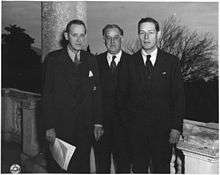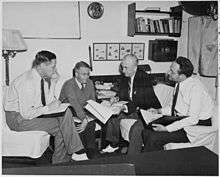Charles E. Bohlen
| Charles E. Bohlen | |
|---|---|
 | |
| United States Ambassador to the Soviet Union | |
|
In office April 20, 1953 – April 18, 1957 | |
| Preceded by | George F. Kennan |
| Succeeded by | Llewellyn E. Thompson |
| United States Ambassador to the Philippines | |
|
In office 4 June 1957 – 15 October 1959 | |
| Preceded by | Albert F. Nufer |
| Succeeded by | John D. Hickerson |
| United States Ambassador to France | |
|
In office October 27, 1962 – February 9, 1968 | |
| Preceded by | James M. Gavin |
| Succeeded by | Sargent Shriver |
| Personal details | |
| Born |
Charles Eustis Bohlen August 30, 1904 Clayton, New York, U.S. |
| Died |
January 1, 1974 (aged 69) Washington, D.C., U.S. |
| Resting place |
Laurel Hill Cemetery Philadelphia, Pennsylvania, U.S. |
| Spouse(s) | Avis Howard Thayer Bohlen |
| Children |
Avis T. Charles E., Jr. Celestine E. Bohlen |
| Alma mater | Harvard University |
Charles Eustis “Chip” Bohlen (August 30, 1904 – January 1, 1974) was a US diplomat from 1929 to 1969 and an expert on the Soviet Union. He served in Moscow before, during, and after World War II, succeeding George F. Kennan as US Ambassador to the Soviet Union (1953-1957). He then became ambassador to the Philippines (1957-1959) and to France (1962-1968). He was an exemplar of the nonpartisan foreign policy advisers who came to be known colloquially as "The Wise Men."
Family
Bohlen was born in Clayton, New York, on August 30, 1904, to Celestine Eustis Bohlen, the daughter of James B. Eustis, a Senator from Louisiana and ambassador to France under Grover Cleveland and Charles Bohlen, a "gentleman of leisure." The second of three Bohlen children, he acquired an interest in foreign countries by traveling in Europe as a boy.[1]
Bohlen graduated from Harvard College in 1927. Bohlen's great-great-uncle was American Civil War general Henry Bohlen, the first foreign-born (German) Union general in the Civil War and the grandfather of Gustav Krupp von Bohlen und Halbach, who used the name Krupp after marrying Bertha Krupp, an heiress of the Krupp family of German weapons makers).
He was thus was related to Alfried Krupp von Bohlen und Halbach, Germany's primary weapons maker during World War II. Krupp was indicted for war crimes at the Nuremberg tribunal, but illness prevented his prosecution.
In 1935, Bohlen married Avis Howard Thayer, born September 18, 1912 in Philadelphia, the daughter of George Thayer and Gertrude Wheeler.[2] The Avis Bohlen award was created and named for her in 1982. It is administered by the American Foreign Service Association and each year honors the US Foreign Service dependent who has done the most to advance US interests.[3]
Her brother, Charles Wheeler Thayer, also a diplomat, worked closely with his brother-in-law, Charles, as US vice-consul in Moscow.
Charles and Avis Bohlen had two daughters, Avis and Celestine, and a son, Charles Jr.[4] The younger Avis became a distinguished diplomat in her own right, who served as deputy chief of mission in Paris, US ambassador to Bulgaria, and US assistant secretary of state for arms control. The other daughter, Celestine, became a journalist and has been a Moscow-based reporter for The New York Times.
Diplomatic career

Bohlen joined the US Department of State in 1929, learned Russian, and became a Soviet specialist, working first in Riga, Latvia. In 1934, at 30, he joined the staff of the embassy in Moscow.
On the morning of August 24, 1939, he visited Hans von Herwarth and received the full content of the secret protocol to the Molotov-Ribbentrop Pact, signed only the day before[5] The secret protocol contained an understanding between Adolf Hitler and Joseph Stalin to split Central Europe, the Baltic States, and Finland between their nations. US President Franklin Roosevelt was urgently informed, but the US did not tell to any of the concerned governments in Europe.
A week later, the plan was realized by the German and Soviet invasions of Poland, and World War II started.

In 1940 and 1941, he worked in the American embassy in Tokyo and was interned for six months before his release by the Japanese in mid-1942. He then worked on Soviet issues in the State Department during the war, accompanying Harry Hopkins on missions to Joseph Stalin in Moscow. He worked closely with Roosevelt and was Roosevelt's interpreter at the Tehran Conference (1943) and the Yalta Conference (1945).
Bohlen, criticized by some of the hawks in the US Congress, paid close attention to public opinion as he considered domestic influence in a democracy to be inevitable.[6] When George Marshall became Secretary of State in 1947, Bohlen became a key adviser to US President Harry Truman.
In 1946, he disagreed with his friend and mentor, Ambassador George F. Kennan, on to how to deal with the Soviets.[7] Kennan proposed a strategy of containment of Soviet expansion, but Bohlen was more cautious and recommended accommodation by allowing Stalin to have a sphere of influence in Eastern Europe without disturbance by the US.
Kennan, declared persona non grata for some criticism of the Soviet Union in Berlin in September 1952, would not be allowed to return to the country. Oversight of the embassy was then awarded Chargé d´Affaires Jacob Beam.
On 20 January 1953, Dwight Eisenhower became US president. When Stalin died in March 1953, the post of ambassador was still empty, and the embassy still being led by Beam.
In April 1953, Eisenhower named Bohlen as ambassador to the Soviet Union. He was confirmed 74-13 despite criticisms from Senator Joseph McCarthy, who had also criticized Bohlen's brother-in-law, also an affiliate of the US embassy in Moscow, Charles W. Thayer.
Bohlen proved unable to sustain good relationships with either Soviet leaders or with Secretary of State John Foster Dulles.. He was demoted on 18 April 1957 by Eisenhower after Dulles forced his resignation.
Bohlen later served as Ambassador to the Philippines (4 June 1957-15 October 1959). He was also ambassador to France (1963-1968) under Presidents John F. Kennedy and Lyndon Johnson. He retired in January 1969.
According to Kennedy advisor Theodore Sorensen, Bohlen participated in early discussions surrounding the Cuban Missile Crisis, inOctober 1962. However, to everyone's surprise he kept reservations aboard an ocean liner that would take him to his Paris post as ambassador rather than waiting until after the crisis had been resolved. He was thus absent for most of what was arguably the most important confrontation between the two superpowers during the Cold War period. He was a consultant in 1968 and 1969 to the transition at the State Department from Secretary of State Dean Rusk to President Richard Nixon's first Secretary of State, William P. Rogers.
Death
Bohlen died of pancreatic cancer at his home in Washington, D.C. on January 1, 1974, at the age of 69. His funeral services, at Washington National Cathedral on January 4, 1974, were followed by burial at historic Laurel Hill Cemetery, Philadelphia.
Legacy
In May 2006, Bohlen was featured on a US postage stamp, one of a group of six prominent diplomats then honored.[8][9][10]
References
- ↑ Charles E. Bohlen, Witness to History, 1929–1969, New York: Norton, 1973, p. 4.
- ↑ "Bohlen, Avis Howard Thayer, 1912–1981.".
- ↑ "AFSA Awards".
- ↑ Charles E. Bohlen, Witness to History, 1929–1969, New York: Norton, 1973, p.37-38, 100, 270, 297.
- ↑ Charles Bohlen, Witness to History: 1929–1969 Norton, 1973, ISBN 0-393-07476-5
- ↑ T. Michael Reddy, "Charles E. Bohlen: Political Realist," in Perspectives in American Diplomacy, ed. Jules Davids, New York: Arno Press, 1976.
- ↑ Harper, John L. Harper, "Friends, Not Allies: George F. Kennan and Charles E. Bohlen," World Policy Journal 1995 12(2): 77-88. ISSN 0740-2775 Fulltext: in Ebsco
- ↑ "Six distinguished diplomats honored on U.S. postage stamps" (Press release). United States Postal Service. 2006-05-30. Retrieved 2008-07-17.
A renowned expert on the Soviet Union, Charles E. Bohlen helped to shape foreign policy during World War II and the Cold War. He was present at key wartime meetings with the Soviets, he served as ambassador to Moscow during the 1950s and advised every U.S. president between 1943 and 1968.
- ↑ Charles E. Bohlen – U.S. Postage Stamps Commemorate Distinguished American Diplomats, US Department of State
- ↑ William J. Gicker, ed. (2006). "Distinguished American Diplomats 39¢". USA Philatelic (print). 11 (3): 14.
Sources
- Ilario Fiore, Lavrenti Il Terribile, (Italian), Torino, 1973. Spanish translation by Juan Moreno: Laurenti El Terrible, 1974, Ed. Plaza y Janés, Esplugas de Llobregat, Barcelona, 509 pages, ISBN 84-01-41049-5
- Walter Isaacson. The Wise Men: Six friends and the world they made: Acheson, Bohlen, Harriman, Kennan, Lovett, McCloy (1986)